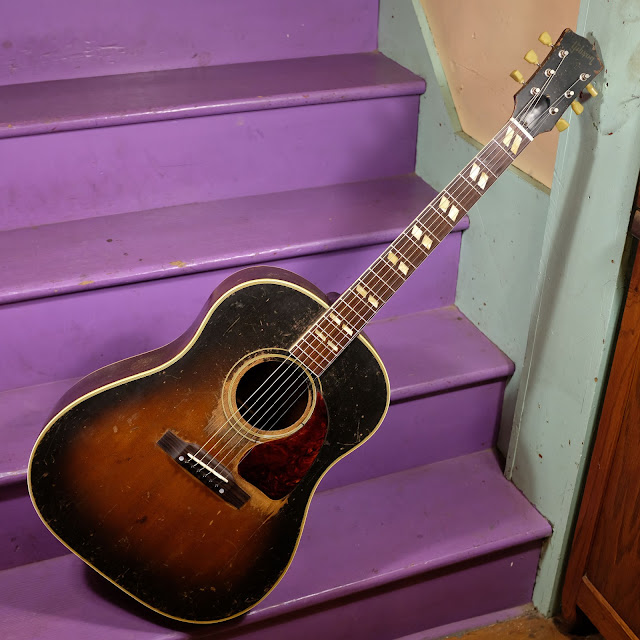1951 Gibson Southern Jumbo Slope Dreadnought Guitar
This old bruiser has got it. Big, gutsy midrange for flatpicking lead work? Check. Woody, full, punchy low-end? Check. Ringing treble with just enough sweetness to keep your ears happy? Check. It turned-out just as well as I was hoping it would. That's a huge thing for me, because this guitar had a lot of time going into it. It's nice to be rewarded in the end, you know?
It came to me via a consignor and when it arrived it had no tuners, no frets or board binding, no pickguard, no bridge, and much of the bracing was either loose here and there or sloppily-repaired in the past. However, all of that pickwear and evidence of honest, loving use told me it would probably end-up a killer guitar. It'd also never been refinished or oversprayed. There was hope!
Work included: making a new repro bridge and installing it, a neck reset, refret with medium-sized stock, new board binding, a replacement celluloid pickguard (one of those LMII Tor-Tis ones), new bone nut and saddle, replacement pins (ebony all around), two replacement center linings for the back on the inside (way down at the lower bout), reglue here and there of many top and back braces, general cleaning, and a good setup. It's now playing perfectly, has a straight neck with working truss rod, and spot-on 3/32" EA and 1/16" DGBE action at the 12th fret, strung with 54w, 42w, 32w, 24w, 16, 12 gauges.
Scale length: 24 3/4"
Nut width: 1 11/16"
String spacing at nut: 1 13/32"
String spacing at saddle: 2 3/16"
Nut width: 1 11/16"
String spacing at nut: 1 13/32"
String spacing at saddle: 2 3/16"
Body length: 20"
Lower bout width: 16"
Upper bout width: 11 1/2"
Lower bout width: 16"
Upper bout width: 11 1/2"
Side depth at endpin: 4 7/8"
Top wood: solid spruce
Back/sides wood: solid mahogany
Neck wood: mahogany
Fretboard: rosewood
Back/sides wood: solid mahogany
Neck wood: mahogany
Fretboard: rosewood
Neck shape: 10" radius with slim-to-medium-C back profile
Bridge: rosewood
Saddle: new bone
Nut: new bone, compensated
Weight: 4lb 1oz
Condition notes: the finish is worn-and-torn all over and there's a ton of pickwear around the soundhole but it's all original except for a buckleworn-area on the back that someone sealed at some point in the past and the back of the neck. The back of the neck appears to have been worn down to bare, more or less, and had a sealer coat put on it a long time ago. I buffed/cleaned-up the neck a little bit, too. There's one folksily-cleated/repaired long hairline crack on the top (but it's good to go), and a few mid-length repairs to hairline cracks on the sides (pictured and also good to go). That's it for cracks. The bridge is a new replacement made by myself -- copied from a '54 bridge. The tuners are replacements and the buttons aren't right for the year, but they are good-quality Gotoh, relic'd units and look great on it. My new binding on the neck is a little thinner than vintage-spec because the "shoulders" that held the old binding were almost entirely gone. In addition, it has a couple of spots next two two of the side dots that are off-color (because of that thinness, oops). The fretboard extension also dips slightly down from the rest of the board past the 14th fret, post-neck-reset. I like to let them drop just a hair so that "summer swell" and moisture expansion doesn't fret you out up there.
It comes with: an old, Guild, arched-lid hard case.
My new rosewood bridge is copied directly from a '54 J-50 bridge, warts and all. The new saddle is tall, has a deep slot, and will give plenty of adjustment-room as-needed for the future.
Here's that old-repaired hairline crack on the top. The "cleats" inside are lightweight but hilarious. It looks like someone just dug-around in their scraps bin for whatever was about the right size. There's a lot of glue residue all over the place inside this guitar, for what it's worth.
The new pickguard doesn't line-up exactly with where the old guard was, but it looks really good nonetheless. I did give it a mild "relic/aging" job to keep it looking more in-line with the rest of the guitar.
I didn't notice the lube coming out of the tuners when I took the photo! Oops! It's wiped-down, now. This had some other tuners on it at some point and there are a few extra misaligned holes creeping-out from under the tuner plates.
The back of the neck has been played! It feels really, really good in the paws.
There are a couple of old-repaired hairline cracks on the sides just below the kerfing.
The new, medium-stock frets feel great. They've got a lot more mass and durability than the original-spec Gibson frets ever would have had which means, for the player, a better feel and gutsier tone.
































Comments
Phil: thanks!